Chess
Notes
|
| First column | << previous | Archives [72] | next >> | Current column |
6655. Marshall v Capablanca

White to move
In a recent ChessBase article about copying we commented on a game (Marshall v Capablanca, fifth match-game, New York, 1909) in which many writers have claimed that White overlooked an immediate win with 45 Qe8+ Kg5 46 f4+ Kg4 (or 46...Kf6 47 Qh8+) 47 Qe2 mate. As is well known, no such win was missed because in the game Marshall’s queen stood not on c6 but on b6.
The oldest citation for the faulty position which was listed by Irving Chernev in his fine scrutiny of the matter (e.g. on page 128 of the May 1951 Chess Review) was ‘Gutmayer’s Schach-Praktiker on page 10’. That book (full title: Der fertige Schach-Praktiker) was originally published in Leipzig, undated but with a Foreword written by Gutmayer in October 1921. The second edition, from the same publisher, was dated 1923. Only the latter volume had the position allegedly from the Marshall v Capablanca game, on page 31:

The mix-up in the diagram and the caption regarding White and Black (as well as the incorrect date – the game was played in April 1909) may be noted. The solution on page 135 also went awry:
Was this the publication to which Chernev was
referring, even though he wrote ‘page 10’?
In C.N 2359 we wrote:
‘When Deutsche Schachblätter published the game on page 67 of its 5 September 1909 issue it gave White’s 43rd move as Qc6+ instead of Qb6. After a consequently incorrect diagram following Black’s 44th move the magazine reported that some chessplayers in Hamburg had found that White could have achieved mate or the win of the queen.’
6656. Marshall team-match game
Marc Hébert (Charny, Canada) notes a game on pages 214-215 of Frank Marshall, United States Chess Champion by A. Soltis (Jefferson, 1994):
1 e4 c5 2 Nf3 e6 3 d4 cxd4 4 Nxd4 Nf6 5 Bd3 Nc6 6 Nxc6 bxc6 7 O-O d5 8 Qe2 Be7 9 Nd2 Qc7 10 Re1 Rb8 11 Nf3 Bc5 12 b3 Ng4 13 Rf1 Bd4 14 Rb1 h5 15 c4 dxc4 16 Bxc4 c5 17 Bb2 Bb7 18 Bxd4 cxd4 19 Rbc1 Qf4 20 Bb5+ Kf8 21 Bd3 Rh6 22 Qd2 Qxd2 23 Nxd2 Ne5 24 Bb1 Ba6 25 Rfd1 Be2 26 Re1 d3 27 h3 Rg6 28 Kh2 Rf6 29 Kg1 h4 30 Rc7 Ng6 31 f3 Nf4 32 Kf2 Rg6 33 Rg1 Rb5 34 Rc8+ Ke7 35 Rgc1 Rxg2+ 36 Ke3 e5 37 R8c7+ Kf6 38 R1c6+ Kg5 39 Rxf7 g6 40 Rxf4 exf4+ 41 Kd4 Rg3 42 e5 Bxf3 43 Rxg6+ Kxg6 44 Bxd3+ Kf7 45 Bxb5 Rxh3 46 Nc4 Rh1 47 Nd6+ Kf8 48 Nf5 Rd1+ 49 Kc3 h3 50 e6 Re1 51 White resigns. (The score here corrects the ‘19 Rac1’ and ‘35 Rfc1’ in Soltis’ book.)
Our correspondent observes that the game was given as won by Marshall against Jacob Rosenthal in the 1913 team match between the Manhattan Chess Club and the Franklin Chess Club, being accompanied by various details about the occasion in Soltis’ narrative of Marshall’s chess activity that year. However, on page 369 of Walter Penn Shipley by John S. Hilbert (Jefferson, 2003) a different game was presented as played in that team match – a French Defence in which Marshall was White against Shipley. Commenting that the latter game was published in the report on the match on page 150 of the July 1913 issue of the American Chess Bulletin, Mr Hébert asks why two games against different opponents have been ascribed to Marshall.
As John Hilbert (Amherst, NY, USA) points out to us, the above Rosenthal v Marshall game was played in the match between the Manhattan Chess Club and the Franklin Chess Club three years later, on 30 May 1916. The game-score was given, together with the full match result, on pages 156-157 of the July-August 1916 American Chess Bulletin.
Marshall v Shipley (1913) was played in Philadelphia, and Rosenthal v Marshall (1916) in New York.
6657. Another Lipschütz
John Blackstone (Las Vegas, NV, USA) sends this item from page 3 of the Brooklyn Daily Eagle, 10 June 1915:

Page 157 of the July-August 1915 American Chess Bulletin reported that the event, the second handicap tournament of the Empire City Chess Club, had recently been won by ‘Philip Lipschuetz, brother of the former United States champion’.
At present, the forename of S. Lipschütz is still uncertain. See the items listed in the entry for him in the Factfinder.
6658. Edward Mason (C.N.s 4183 & 6646)
Leonard Barden (London) notes that Mason can be seen in a Pathé newsreel.
‘He appears twice, about three-quarters of the way through the film, and the two shots of him are close together. He is on the right-hand side of the picture, the tall, bespectacled man smoking a pipe (with smoke emerging from it in the first of the shots).’
6659. Chigorin (C.N. 6632)
Robert Sherwood (E. Dummerston, VT, USA) points out that Chigorin signed his name ‘M. Tchigorine’ on a picture card reproduced on page 81 of The Second International Chess Tournament Ostende 1906 edited by A.J. Gillam (Yorklyn, 2005). The card, owned by the book’s publisher, Dale Brandreth, is a remarkable piece of memorabilia, signed by all the participants in the master tournament.
Dale Brandreth, one of the chess world’s best
booksellers, now has a website.
6660. Pure mates (C.N. 6648)
From Michael McDowell (Westcliff-on-sea, England):
‘The problemist’s definition of a pure mate is mate where every square around the mated king is blocked or guarded only once, and the king’s square is attacked only once. A double check is allowed if each check would individually be refuted (hence “essential double check”). Where a pin is involved it is deemed not to matter whether or not the pinned piece is blocking a flight square.
The Krebs v Ginsburg finish in C.N. 6648 is not a pure mate because a7 is both blocked and guarded, but there must be any number of games ending in pure mates. Some standard mates (e.g. Philidor’s legacy, Boden’s mate and the epaulette mate) are naturally pure. I have looked through Chernev’s 1000 Best Short Games of Chess (only the games with diagrams) and note that all the following have pure mates: 42 (essential double check), 44 (Bd8), 96, 97 (again, essential double check), 110, 147, 153, 168, 212, 218, 225, 266 (perhaps the most beautiful example), 291, 310, 323, 402, 439, 466, 597, 605 (Steinkühler v Blackburne), 610, 694 (including a pin), 751, 758, 767, 778, 792, 943, 952 and 967.
More interesting are the games which end in a model mate, a pure and economical mate (economical being defined as employing all of the mating force with the possible exception of king and pawns). Anderssen’s celebrated games against Kieseritzky and Dufresne (945 and 991 in Chernev’s book) both end in models, as do games 815, 824, 827, 855 and 868. Game 341 ends in a pin-model.
A famous game which ended in a pretty model mate is Nimzowitsch v Tarrasch, St Petersburg, 1914.’
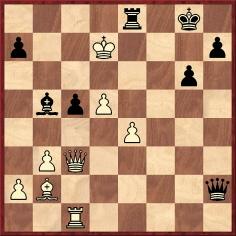
The game described above by Mr McDowell as ‘perhaps the most beautiful example’ in Chernev’s book is on pages 120-121. Although it is headed as Amateur v Barcza, Budapest, 1939, we note different information on page 13 of Barcza Gedeon élete és játszmái by István Bilek (Budapest, 1990):

6661. Both colours (C.N. 6611)
As regards pieces with heads of the opposite colour, we are grateful for a number of contributions.
Concerning the Soviet Union, Gerd Entrup (Herne, Germany) notes that such pieces are shown in photographs in the Botvinnik volume on the 1963 world championship match (the English version of which was published by New in Chess earlier this year). Other examples are the photographs in R.G. Wade’s match book, as well as this shot of Petrosian on the front cover of the May 1963 Chess Life:

With regard to Poland, Tomasz Lissowski (Warsaw) recalls the photograph of Dolo Falk which he provided in C.N. 4623. See also the photographs of Capablanca in Warsaw in 1935 which he contributed in C.N. 6489. Furthermore, our correspondent recollects occasionally seeing pieces with different coloured heads even in the 1970s, whereas the Staunton pattern now has to be used in official events.
In Austria, Charles Milton Ling (Vienna) informs us, bishops with mitres of the opposite colour were still in regular use in tournament competition until the 1980s, after which the Staunton design became universal.
Karel Mokrý (Prostějov, Czech Republic) writes:
‘I believe that bishops (as well as kings and queens) have had heads of the opposite colour since the 1880s. They were designed around 1885-86 by Bohuslav Schnirch, who was the first President of the first chess club of importance in Czech countries: the Český spolek šachovní, founded in 1884.
There are many variations of the Schnirch pieces, and C.N. 6611 gave two examples. The pieces in the Pachman picture are closer to the original pieces than those being used by Hromádka. All these variations were also called “České klubovky”.
For a short period, in 1946-47, copies of old Schnirch pieces were manufactured, but the Communist putsch of February 1948 ended that.’
6662. Cable match
Jan Kalendovský (Brno, Czech Republic) sends a photograph from page 360 of the 1 April 1910 issue of Sport im Bild:
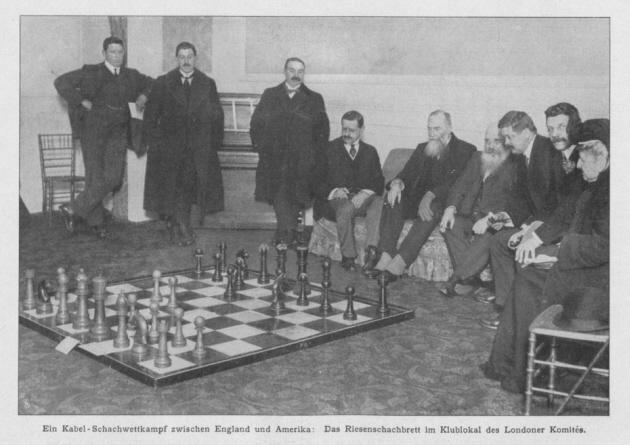
Identification assistance will be appreciated.
6663. Alan Bennett
Readers are invited to explain the reference in an extract from Alan Bennett’s diary entry of 10-20 May 1988, covering his visit to Russia, on page 170 of his brilliant book Writing Home (London, 1994):

6664. A nineteenth-century photograph
Jane LaRoque (Boyceville, WI, USA) asks for information about a photograph (trimmed size: 3⅝ x 2⅜ inches) which she acquired from an estate auction in Eau Claire about a decade ago:



Detail from the reverse of the photograph

Album page which
enclosed the photograph

6665. Fleissig v Schlechter
Jan Kalendovský (Brno, Czech Republic) draws attention to this cutting from the Allgemeine Sport-Zeitung of 13 August 1893, page 841:

With regard to the surprising statement that Schlechter was White, Mr Kalendovský reports that no correction appeared in any of the three subsequent columns. He asks what the truth is about this famous miniature.
It has often been dated 1895, and the book on that year’s Hastings tournament (page 352) stated concerning Schlechter:
‘His memorable game with Fleissig influenced the Committee greatly in selecting him.’
We discussed the game in C.N. 1128, quoting a contribution from the late Warren H. Goldman (Gaiberg, Germany), who was writing a monograph on Schlechter. At that time (February 1985) he believed the date of the game to be 10 October 1893, although with later research he concluded that the correct date was 10 August 1893, as given on page 12 of Karl Schlechter by R. Spielmann (Stockholm, 1924):

With the words Caveat lector we concluded C.N. 1128 by drawing attention to Every Game Check Mate by W.H. Watts and P. Hereford (London, 1932), which indicated on page 115 that Schlechter was White (and that the game was played in Munich in 1895):

It may be noted that the game had appeared on page 68 of the earlier volume Every Game Check Mate! by J. Douglas (London, 1916), with Schlechter as Black and no occasion specified:

Information about the game’s early appearance in magazines, and especially in 1893, will be appreciated. The score was given on pages 52-53 of the February 1894 Deutsche Schachzeitung, although with no mention of Schlechter. There was particularly cautious phraseology about the game having allegedly been lost recently by Fleissig (‘Angeblich soll diese Partie von dem Wiener Schachspieler Fleissig kürzlich verloren worden sein’). In 1895 the game was published more widely. For example, it appeared (without a date or occasion, but with notes by Mason) on page 353 of the August 1895 BCM, the score having been taken from the Times-Democrat. It was also given (headed Vienna, 1893) on page 122 of the December 1895 Chess Monthly.
The game is on pages 497-498 of Goldman’s posthumous book Carl Schlechter! Life and Times of the Austrian Chess Wizard (Yorklyn, 1994), with Schlechter specified as the winner and the occasion given as Vienna, 10 August 1893. It seems to us that those details are most likely to be correct, but, as ever, any further evidence – for or against – will be very welcome.
6666. Daily chess column (C.N. 4836)
An item in Steinitz’s ‘Personal and General’ column on page 114 of the April 1885 International Chess Magazine:

The unpublished list of newspaper columns compiled by H.J.R. Murray specified (item 1560) that the columnist was Sam Loyd.
6667. Chigorin (C.N.s 6632 & 6659)
With the permission of Dale Brandreth (Yorklyn, DE, USA) we reproduce the card referred to in C.N. 6659:
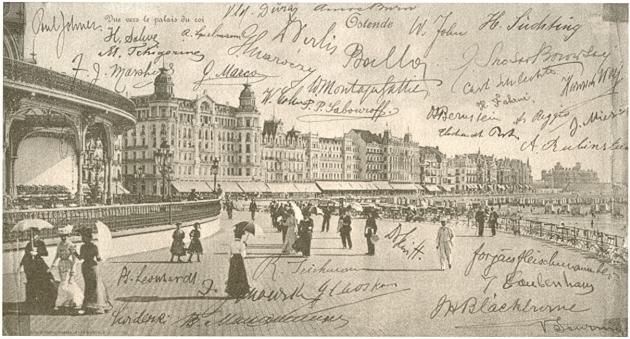
6668. Fleissig v Schlechter (C.N. 6665)
From Peter Anderberg (Harmstorf, Germany):
‘I would draw attention to the correspondence item which begins “Wien (B.F.)” on page 127 of the April 1894 Deutsche Schachzeitung. Fleissig admitted having lost the game in question to Schlechter, although he considered it a skittles game (“Husarenpartie”).
So there is no doubt about the authenticity of the game or about who won. The footnote on page 497 of Goldman’s book on Schlechter is obviously based on that Deutsche Schachzeitung item, although no source is given.
Deutsches Wochenschach published the game as played “some weeks ago in Vienna” on page 206 of its 30 June 1895 issue, quoted from the Times-Democrat.
The date “10 August 1893” is given (for the first time?) on page 52 of Carl Schlechter. Sein Leben und Schaffen published by B. Kagan in early 1920. The book included a collection of games mainly played in Schlechter’s youth:
“Ich lasse hier eine Anzahl Partien hauptsächlich aus seiner Jugend folgen, welche ich aus seinen persönlichen Notizen entnommen habe und die der Schachwelt weniger bekannt sind.”
These games were presumably taken from “Schlechter’s handwritten Notizbuch” mentioned on page 536 of Goldman’s book and now in Lothar Schmid’s possession.’
6669. Queen’s knight’s pawn (C.N.s 5827, 5865 & 6021)
From page 94 of Chess Traps, Pitfalls, and Swindles by I.A. Horowitz and F. Reinfeld (New York, 1954):

6670. Alan Bennett (C.N. 6663)
A number of readers have suggested that the quote in Alan Bennett’s diary may have been a reference to the 1957 Ingmar Bergman film The Seventh Seal, although the particular point of the remark has yet to be explained. That, in fact, was where we stood before C.N. 6663 was posted, and further ideas will be appreciated.
The Seventh Seal was featured on the front cover of Chess Life & Review, April 1979 and discussed by Frank Brady on pages 456-457 of the August 1979 issue.

6671. Draws
Kristo Miettinen (Rochester, NY, USA) asks about the various ways in which draws have been scored in chess tournaments and matches since the mid-nineteenth century:
‘For instance, the phrase “draws do not count” in match play has meant different things at different times; in the first American Chess Congress, at New York in 1857 (to name but one early event) drawn games did not count even for purposes of alternating colors, so that two players who drew played their next game with the same colors as in the draw, until a decisive result was scored. Only after decisive results were colors alternated.
Many descriptions of nineteenth-century tournaments also mention that drawn games had to be replayed, but without indicating whether colors were alternated for the replay.
Other oddities include the Paris, 1900 tournament, in which draws were replayed once only, with alternation of colors, but a second draw stood as the final result.
My interest is in the effect that such rules may have had on opening selection. For instance, rules that required a player with the black pieces to continue playing black until he won (or lost) a game would strongly discourage playing to draw from the outset with Black, regardless of the opponent.’
Do readers know of any systematic treatment of this matter?
It will be recalled that some tournaments deviated from the practice of awarding half a point for a draw. A notable example was Monte Carlo, 1901, and we quote from page 373 of the December 1900 issue of La Stratégie:
‘La première partie nulle comptera pour ¼ à chaque joueur et devra être rejouée; si l’un d’eux gagne la seconde elle lui sera comptée ¾ en tout; si elle est encore nulle chacun aura ½ point. Cette modification pour les nullités a été suggérée par M. le Dr E. Lasker.’
Or, as Jeremy Gaige summarized the system on page 171 of volume two of Chess Tournament Crosstables (Philadelphia, 1971):
‘Initial games, if drawn, counted ¼ and were replayed. If the replayed game was drawn, both players won another ¼. The winner of a replayed game received ½, the loser 0.’
The identical wording turned up on page 6 of Chess Results, 1901-1920 by Gino Di Felice (Jefferson, 2006).
In case of a draw at Monte Carlo, 1901 there was alternation of colours for the second game. See, for instance, A.J. Gillam’s booklet on the tournament (Nottingham, 1995) and, in particular, the discussion of the experimental scoring system on pages 67-70.
6672. Signed Alekhine pictures
Gloria Martín and Javier Boldó (Santa Cruz de Tenerife, Canary Islands, Spain) possess two pictures inscribed by Alekhine:


The second item (with Alekhine’s inscription, written a few months before he died, on a photograph of a sketch made five years previously) is of particular interest. The warm dedication is to Alvaro Díaz, whom Alekhine thanks for his many kindnesses, adding that he hopes to see Díaz again at a less turbulent time in his life.
6673. Fischer v Bolbochán
In Fischer’s Fury we continue to add items of relevance to the controversy over the game against Bolbochán, Stockholm, 1962. The latest addition is from page 209 of The Golden Dozen by Irving Chernev (Oxford, 1976):

6674. Both colours (C.N.s 6611 & 6661)
Maurice Carter (Fairborn, OH, USA) draws attention to
the pieces in four photographs from Debrecen, 1925 which
were published on pages 208-209 of Kagans Neueste
Schachnachrichten, January-March 1926:




These photographs, together with others taken at Debrecen, 1925, were also published in Das entfesselte Schach by S. Tartakower (Kecskemét, 1926).
6675. Debrecen, 1925
Following on from the previous item, we give below photographs of the remaining ten participants in Debrecen, 1925, as published in Tartakower’s Das entfesselte Schach:

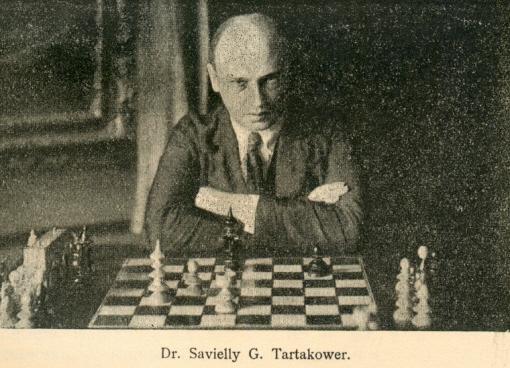






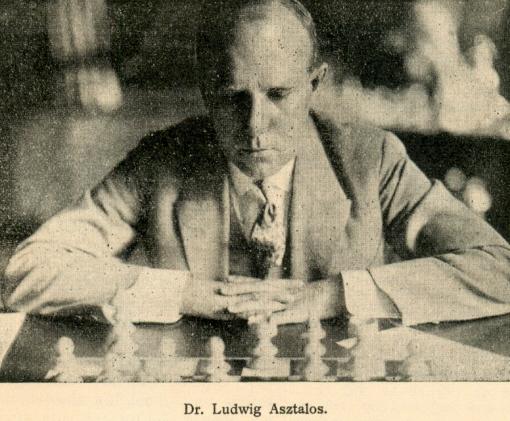

6676. Draws (C.N. 6671)
From Robert John McCrary (Columbia, SC, USA):
‘In early events the English rule was that a player retained the first move for the next game when a game had been drawn. This did not necessarily mean keeping the same color, as the rule that White moves first was not fully established until later.
That rule was in effect for the McDonnell-Labourdonnais games, because it was “according to the English law” (page 374 of the fourth volume of the Chess Player’s Chronicle, 1843). Staunton’s The Chess-Player’s Handbook (London, 1847) stated on page 36 that players alternate the first move, except that “If a game be drawn, the player who began it has the first move or [sic] the following one”. This is presumably why the First American Chess Congress (New York, 1857) used this rule, as page 63 of that tournament book stated that the Code in Staunton’s Handbook would govern play, adding on page 64, “Drawn games are not to be counted”.
However, a movement to change this rule was evident as early as 1844. Page 156 of that year’s Chess Player’s Chronicle (volume five) noted that the match between Stanley and Schulten in New York required the first move to alternate even in case of draws. On pages 252-253 of that same volume a correspondent advocated requiring that the first move alternate even in case of draws. Staunton expressed agreement with that change, which he said was already the rule in France and, he believed, throughout the continent. Thus, it seems that Staunton’s publication of the old rule in his Handbook was based on earlier codes, and not necessarily on his own opinion.
On page 188 of the London, 1851 tournament book Staunton said that the players at that event had voted to alternate the first move even in case of draws, although this rule had been forgotten or ignored in one of the games.’
6677. Yarns
Regarding the Nimzowitsch anecdote about an opponent who threatened to smoke, the longest version known to us is on pages 4-5 of The Pleasures of Learning Chess by Fairfield W. Hoban (New York, 1974). Forty lines of text, with abundant direct speech, are squeezed out of the alleged episode. After Lasker’s cigar has been ‘slowly and carefully unwrapped’ and Nimzowitsch has ‘exploded, leaping to his feet and shouting for the tournament director’, Lasker says, ‘What seems to be the trouble, Aron?’ In reply, Nimzowitsch howls, ‘You know very well what the trouble is’ and accuses Lasker of trying ‘to interfere with my thinking and to ruin my game and I won’t have it!’
The tournament director, Maróczy, is given hardly any dialogue, stilted or otherwise, and the apogee is a final rant by Nimzowitsch:
‘“But that isn’t the point! That isn’t the point!,” shrieked the now-hysterical master. “Everyone knows that Dr Lasker has written that the threat is much stronger than the execution!”’
Overleaf (page 7) Hoban presents, without any sense of propriety, his variant (nearly 40 lines more) of the Rubinstein story, i.e. the family’s alleged encounter with the SS during the Second World War. For example:
‘The Nazis looked at each other. The leader spoke. “That’s all irrelevant, madam. Here are the forms for you to complete. Pack your belongings and be ready to leave tomorrow morning at 8.00 a.m.” They turned and stamped down the stairs.’
By the next morning, however, the stamping SS officers had become tender-hearted and munificent, and once again Hoban is in possession of the exact words spoken (or, better say, an English translation thereof):
‘The plans are changed, Frau Rubinstein. You and your son will not be leaving, after all. I have been given orders to issue you these identification papers, ration books, and this sum of Reichmarks. You will not be troubled any further.’
Hoban knows everything except the identity of the ‘unknown guardian, a benefactor whose name never was revealed, but whose memories of happier days and beautiful chess games had been reawakened when he saw the name of a chess immortal – Akiba Rubinstein – on his death list’.
6678. A.C. White’s bookplate
Martin Hopkinson (London) asks for information about the chess bookplate for the Alain White Collection, now housed in the South African National Library. White was also a botanist, and the bookplate combined his two interests.
As Michael McDowell (Westcliff-on-sea, England) points out to us, the bookplate was reproduced on page 82 of Some Problems For My Friends by D.G. McIntyre (Cape Town, 1957):

The book’s next two pages had an article ‘The Alain White Collection in the South African Library, Cape Town’ by D.H. Varley, the Chief Librarian.
Our collection includes a copy of McIntyre’s book inscribed to Varley:

A three-mover by McIntyre, highly praised by A.C. White, was given in C.N. 2882. See page 319 of Chess Facts and Fables.
6679. The Lasker brothers
From page 165 of the November 1928 American Chess Bulletin:

6680. The Capablanca family
A photograph on page 66 of the 7-8/1974 issue of the Cuban magazine Jaque Mate:

Full-page article (by Carlos A. Palacio)
6681. Krejcik
A number of books say that Krejcik won the following game in 1921:
1 e4 d5 2 Nf3 dxe4 3 Ng5 Qd5 4 d3 exd3 5 Bxd3 Qxg2 6 Be4 Resigns.

See, for instance, page 103 of Assiac’s Adventure in Chess (London, 1951), although it stated that ‘Krejzick’ defeated ‘master Takasch’ in 1921. The same spellings and date appeared on page 102 of Pour mieux jouer aux échecs by Maurice Beaucaire (Paris, 1967).
Krejcik himself gave the game as one of a pair on pages 25-26 of Mein Abschied vom Schach (Berlin, 1955):


6682. Bad Kissingen, 1928
John Blackstone (Las Vegas, NV, USA) notes a report on page 6A of the Brooklyn Daily Eagle, 6 September 1928 that Euwe defeated Yates at that year’s Bad Kissingen tournament:

In reality, Euwe was White, and Yates’ victory was highly praised on pages 159-161 of the tournament book by Tartakower. Yates’ own notes appeared on pages 101-102 of his posthumous book One-Hundred-and-One of My Best Games of Chess (London, 1934).
6683. The Pearl of Zandvoort
One of Euwe’s most famous wins is the ‘Pearl of Zandvoort’, the 26th game of his 1935 world title match against Alekhine. See, for instance, page 150 of Euwe’s From My Games 1920-1937 (London, 1938) and such well-known books as Wellmuth’s The Golden Treasury of Chess, Fine’s The World’s Great Chess Games and Schonberg’s Grandmasters of Chess. Various chess encyclopaedias (e.g. by Sunnucks, Golombek and Brace) have an entry for the ‘Pearl of Zandvoort’, and it is, in short, a matter on which no half-competent writer would go wrong.
From page 158 of The Big Book of Chess by Eric Schiller (New York, 2006):

The Euwe win given by Schiller as the ‘Pearl of Zandvoort’ was played in Amsterdam.
6684. Nimzowitsch on Alekhine
Page 33 of The World Champions Teach Chess compiled by Y. Estrin and I. Romanov (London, 1988) quoted a comment by Nimzowitsch after Alekhine’s triumphs at San Remo, 1930 and Bled, 1931:
‘He makes short work of us as if we were little chickens.’
We are unaware of a Russian edition of the book, but the German version, Weltmeister lehren Schach (Hollfeld/Obfr., 1985), had put the following:
‘Er legt uns wie Grünschnäbel um.’
The most direct translation of Grünschnäbel is ‘greenhorns’ or, possibly, ‘whippersnappers’.
Nimzowitsch’s remark was quoted by Hans Kmoch in an article on Alekhine at the Chess Café:
‘At Bled, Alekhine’s superiority drove the proud Nimzowitsch to despair. When he resigned to the world champion after only 19 moves he was near tears. “It’s incredible”, he complained. “Only a few years ago we were all about equal”, he said, referring to the chess elite of that time, “but now he treats us like patzers.”’
Kmoch was present at the Bled, 1931 tournament. Page 53 of the English edition (Yorklyn, 1987) of his book on the event, translated by Jimmy Adams, had the following text in the introduction to the round in which the Alekhine v Nimzowitsch game was played:
‘Nimzowitsch could not recover from his astonishment. After taking both pawns, he left the board and, shaking his head, repeated several times, “He is treating us like patzers.”’
The words ‘He is treating us like patzers’ were also quoted, by Flohr, on pages viii-ix of the English book, in a 1976 article translated from 64.
The original edition of the Bled, 1931 tournament book
(Leningrad, 1934) was a translation of Kmoch’s
unpublished German text, which may or may not be extant.
Below is the relevant passage, from page 53:

The quote attributed to Nimzowitsch is:
‘Он обращается с нами, как с желторотыми птенчиками.’
A literal rendering is ‘He treats us like yellow-beaked fledglings’. The term ‘yellow-beaked’ in Russian means young and inexperienced.
It is hoped that other sightings of the Nimzowitsch quote can be found. The unsatisfactory situation at present is that we have Estrin’s text in German but not the original Russian and Kmoch’s text in Russian but not the original German.
6685. Adolf Zinkl (C.N.s 3834, 4839 & 4840)
Olimpiu G. Urcan (Singapore) sends us, courtesy of Peter Michael Braunwarth (Vienna), photographs of Adolf Zinkl’s grave in the Zentralfriedhof Wien (door 2, group 41F, row 13, number 15):


6686. The Capablanca family (C.N. 6680)
From Calle Erlandsson (Lund, Sweden) comes this first-day cover (issued on 1 November 1951) with the signatures of Zenaida Capablanca, Gloria Capablanca de Palacios, Graziella Capablanca, Aída Capablanca and José R. Capablanca Jr.:
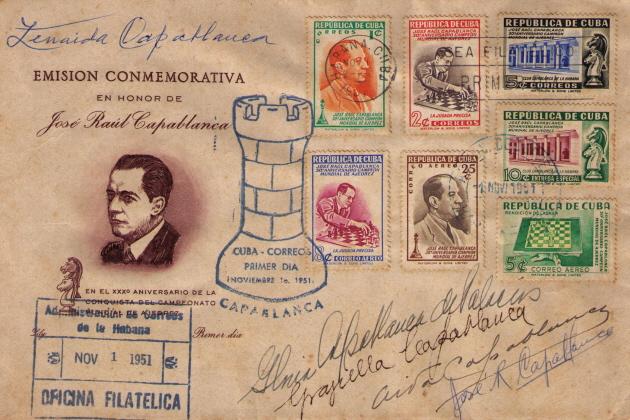
6687. David DeLucia’s collection (C.N.s 3164, 5323 & 6189)
A fine article by Dirk Jan ten Geuzendam on pages 10-21 of the 5/2010 New in Chess concerns the chess library of David DeLucia. A particularly welcome piece of information is that in a planned new volume based on his collection Mr DeLucia intends to reveal the Capablanca v Tartakower game discussed by Olga Capablanca Clark in C.N. 1383 (see The Genius and the Princess).
6688. Lipschütz
Eduardo Bauzá Mercére (New York, NY, USA) forwards us page 462 of the fourth issue of Club Men of New York, 1901-02 (New York, 1901):

The publication announced its scope as follows:
‘Full membership of the leading clubs, societies, college alumni associations, &C, of Greater New York * Occupations, business and home addresses * Historical sketches of all prominent New York organizations * Principal clubs, with addresses, in the 100 largest cities of the United States.’
Our correspondent also quotes from pages 3-4:
‘Every effort has been made in this issue, however, to secure accuracy, even at the expense of delaying publication nearly 60 days. While the various official lists of members, courteously furnished (often with addresses) by the officers of almost every club, have been the first and principal authority for the information herein contained, a personal letter of enquiry with return information blank was sent to each person whose name appears in this work. In addition, a great number of supplemental inquiries were sent out. Thousands of replies have been received, adding greatly to the accuracy and value of the work.’
For convenience, we have brought together the various C.N. items on this topic in S. Lipschütz – Samuel, Simon or Solomon?
C.N. 3172 noted that Lipschütz died in Hamburg, and we are still hopeful that a reader in that area will be able to check the local records for references to the master’s forename.
6689. Deschapelles
Pierre Baudrier (Paris) draws attention to his researches into Deschapelles in the section entitled ‘Les créations du club’ at the website of the Association Gennevilloise des Echecs.
6690. London, 1851
From Mario Ziegler (Nonnweiler, Germany):
‘Shortly after Staunton brought out his London, 1851 tournament book a German translation was published in Berlin: Das Schach-Turnier zu London im Jahre 1851 (“Nach Staunton’s Chess Tournament”). Given that the anonymous author sometimes advances a different view from Staunton’s, it would be interesting to know his identity.
Also, is it possible to name the anonymous author of the pamphlet A Review of “The Chess Tournament”, by H. Staunton, Esq., by a member of the London Chess Club (London, 1852)?’
Extracts from the latter work, a 26-page pamphlet, were given in Attacks on Howard Staunton. Our copy has three markings. In the term ‘wilful misrepresentation’ on pages 9 and 12 the adjective has been deleted, although it remains fully legible. On page 14 the word ‘character’ has been similarly deleted, replaced by hand with ‘reputation’.


The copy of the pamphlet available at Google Books has the same textual amendment, although handled in such a way that ‘character’ is no longer visible.
6691. Blackburne’s announced mate in 16
Marc Hébert (Charny, Canada) asks for information about the famous blindfold game in which J.H. Blackburne announced mate in 16 moves.
The conclusion was published on page 211 of Mr Blackburne’s Games at Chess by P. Anderson Graham (London, 1899), with the solution on page 326:


Thus the only information supplied was Black’s name: Scott. It was not stated that the game had occurred in a simultaneous display, although that assumption is commonly made.
The position was given on page 41 of Blindfold Chess by E. Hearst and J. Knott (Jefferson, 2009), the co-authors stating that they had been unable to find any further particulars. Where, if anywhere, was the position published before the appearance of P. Anderson’s Graham book? We also seek bare references in nineteenth-century sources to such a game, or to an opponent of Blackburne’s named Scott.
6692. Alekhine v Bogoljubow
‘No world championship match ever produced a finer struggle than this.’
So wrote R.N. Coles on page 119 of Battles-Royal of the Chessboard (London, 1948), with regard to the 11th game of the 1929 Alekhine v Bogoljubow match. (He placed the game, a 63-move draw, in Wiesbaden instead of Heidelberg.)
Bogoljubow’s annotations were published on pages 408-410 of the December 1929 Kagans Neueste Schachnachrichten.
From page 170 of the November 1929 American Chess Bulletin:

6693. Laroche
Rod Edwards (Victoria, BC, Canada) writes:
‘On page 228 of Chess Results, 1747-1900 (Jefferson, 2004) Gino Di Felice gives “Laroche” a first initial “H.”, and the book lists two match results for him (against de Rivière in 1856 on page 21 and against Harrwitz in 1860 on page 31). He does not indicate a source for the initial “H.”.
The question is complicated by the fact that there were two notable players named “Laroche” in France in the mid-nineteenth century. The Laroche (sometimes given as Delaroche, De La Roche or La Roche) who played de Rivière and Harrwitz, as well as Morphy (see page 177 of Edge’s book on Morphy), was born in Bayonne in the south of France (Le Palamède, 1845, page 524) but was a member of the Paris Chess Circle for many years. He was among the opponents of Labourdonnais when the latter played blindfold (Le Palamède, 1838, page 58). In 1845 he moved back to Bayonne (Le Palamède, 1845, page 524) and was subsequently often referred to as “Laroche, de Bayonne” (e.g. Le Palamède, 1846, page 474). He was considered for many years one of the strongest players in France (e.g. the Chess Player’s Chronicle, 1844, page 2; La Nouvelle Régence, 1860, page 93). His death was announced in the 15 April 1866 issue of Le Sphinx (page 3).
There was also a “docteur Laroche” in the Paris Chess Circle from the earlier part of the nineteenth century (Le Palamède, 1845, page 30) until his death in 1850 (La Régence, 1850, page 225). He too was described as one of the strongest Parisian players (La Régence, 1850, page 225), and it was this Laroche who played so effectively in the match between the Cercle des Echecs and the players of the Café de la Régence in 1849 (La Régence, 1849, pages 129-131; Illustrated London News, 6 June 1849, page 400; Chess Player’s Chronicle, 1849, pages 188-190).
That these are distinct players is made clear by their separate appearances in lists of members (and honorary members) of the Paris Chess Circle (Le Palamède, 1845, page 135; La Régence, 1849, page 164) and in the list of subscribers to Kieseritzky’s book Cinquante Parties published in 1846 (page 49). Furthermore, in 1851 Kieseritzky bemoaned the departure of several strong players from Paris, including “Laroche”, and the death of several others, including “le docteur Laroche” (La Régence, 1851, page 134).
To make matters more complex, there was at least one other player named “Laroche” in Paris about that time, though not mentioned often. A membership list of the Paris Chess Circle in 1851 mentions a “Laroche (Félix de)” as well as “Laroche, de Bayonne” (La Régence, 1851, pages 36-37), and when the latter visited London at the time of the international tournament of 1851 he was accompanied by “Laroche jeune, son frère” (La Régence, 1851, page 198).
A player named “Laroche”, no doubt one of the two more famous ones, appears in the picture of the Staunton-Saint Amant match discussed in C.N. 4259, as number 26 in the index. Etienne Cornil identified him as “docteur Laroche” (on page 35 of “Le Café de la Régence” – the account referred to in C.N. 5241), while Le Palamède (1845, page 403) identified him only as “Laroche”.
I have not found an early source (nineteenth century) giving the first name or initial of either of these players.’
We note that whereas the index on page 349 of P.W. Sergeant’s book Morphy’s Games of Chess (London, 1916) had ‘La Roche’, later editions amended this to ‘La Roche, Dr H.’. In David Lawson’s volume on Morphy the index (page 420) put ‘Laroche, M.’. It is possible, though, for misunderstandings to arise with the initials M. and H. as a result of their use as abbreviations for Monsieur and Herr. For an example concerning Monsieur, see The Fox Enigma.
6694. Planning (C.N. 5884)
C.N. 5884 quoted a couple of sentences about planning
from page 28 of Better Chess by William
Hartston (London, 2003). The full section is worth
recalling:
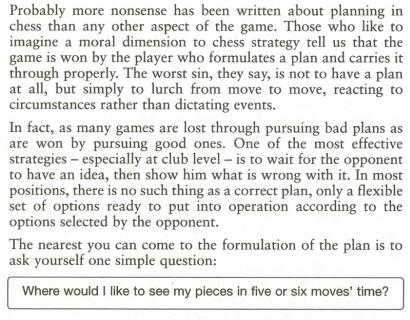
Another notable comment is on page 22:
‘The “knights before bishops” nonsense is a specific case of a much more sensible piece of advice on development: Play the obvious before the optional.’
6695. Nimzowitsch on Alekhine (C.N. 6695)
On pages 67-69 of the March 1932 issue of Kagans
Neueste Schachnachrichten Nimzowitsch wrote an
article about whether his third place at Bled, 1931
(after Alekhine and Bogoljubow) was to be regarded as a
relative failure:



In the passage marked with red Nimzowitsch states that his two defeats against Alekhine prove nothing. He mentions that although at one time he suffered a series of defeats against Bogoljubow, his latest score against him in tournament games is four wins, three draws and no losses. Nimzowitsch adds that as recently as 1930 (presumably 1920, since he also writes ‘after the War’) he stood equal with Alekhine; moreover, he had a tied result in his games with him at New York, 1927. Nimzowitsch’s conclusion is that Alekhine, to demonstrate his superiority, would have to defeat him in hard battles, whereas his two victories over him in the Bled tournament, one in gambit style and the other by catching him out with a pretty trap, proved absolutely nothing and were certainly pure chance.
6696. A mate in three by Nimzowitsch
From page 70 of Kagans Neueste Schachnachrichten, March 1932:
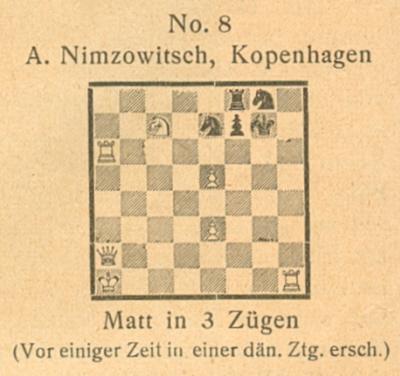
Wanted: details about the composition’s prior appearance in a Danish publication, as mentioned in the caption.
6697. Capablanca in colour (C.N.s 3442 & 3447)

The picture was discussed on page 46 of the March 1915 American Chess Bulletin:

6698. Blackburne’s announced mate in 16 (C.N. 6691)
Jerry Spinrad (Nashville, TN, USA) draws attention to the Sydney Mail of 19 February 1887 (page 411), which reproduced from the Fortnightly Review an article by L. Hoffer entitled ‘The Chess Masters of Today’. It was stated:
‘There are masterpieces of Blackburne’s blindfold games published in which he has announced checkmate in 17 moves.’
We note that the same remark appeared on page 162 of the Chess Monthly, February 1889.
Which games published before 1887 could Hoffer have had in mind?
Taylor Kingston (Shelburne, VT, USA) comments regarding the position in C.N. 6691, where Blackburne is said to have announced mate in 16 moves, that White can give mate in eight. After 1 Rxe6+ Kh7 2 Qd3+ Rg6 the announced mate was 3 Qxg6+ fxg6 4 Re7+ Kg8 5 Be6+ Kf8 6 Rf7+ Ke8 7 Nf6+ Kd8 8 Rd7+ Kc8 9 Rxa7+ Kb8 10 Nd7+ Kc8 11 Nc5+ Kd8 12 Rd7+ Kc8 13 Rf7+ Kd8 14 Nb7+ Ke8 15 Nxd6+ Kd8 16 Rd7. The analysis engine Rybka agrees that this is the best play for both sides if White chooses 3 Qxg6+, but it gives the line 3 Rxg6 fxg6 4 Qxd6 Qd1+ 5 Bxd1 gxh5 6 Qe7+ Kh8 7 Bd4+ Kg8 8 Qg7 mate.
6699. Code
Further to the report in C.N. 3345 (see page 244 of Chess Facts and Fables), below is a paragraph from page 468 of the December 1896 BCM:
‘The long-expected return match between Messrs Lasker and Steinitz, for the championship of the world, began at Moscow, on 7 November, having been delayed a few days owing to a political difficulty. Mr Steinitz had arranged to telegraph the games to America in cypher, which cryptogram, however, had to be submitted first to the censorship of the Russian government, and it took some time to convince the authorities that there was nothing nihilistic in the mysterious messages to be sent.’
6700. A mate in three by Nimzowitsch (C.N. 6696)
Michael McDowell (Westcliff-on-sea, England) notes that Nimzowitsch’s composition was included on page 83 of Godehard Murkisch’s book Rätselvolle Schachaufgaben (Munich, 1985), the source being stated as the Baltische Zeitung, 1919. White’s king was on c1, and not a1. Nikolai Brunni (Honolulu, HI, USA) mentions that that same position is given online at a Nimzowitsch page (‘Baltische Zeitung, 1918’).
| First column | << previous | Archives [72] | next >> | Current column |
Copyright: Edward Winter. All rights reserved.

